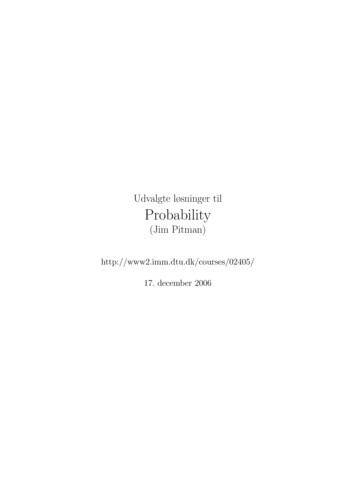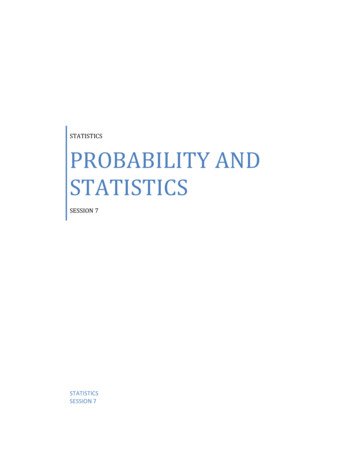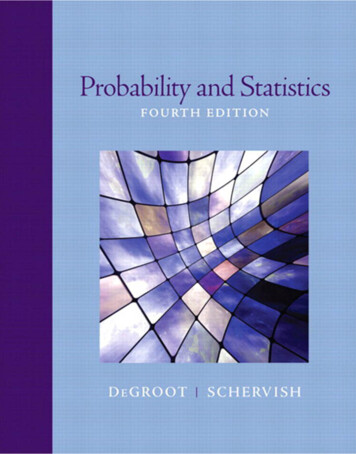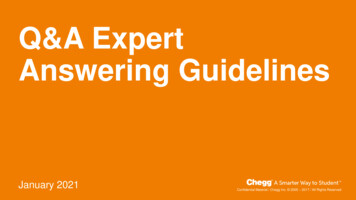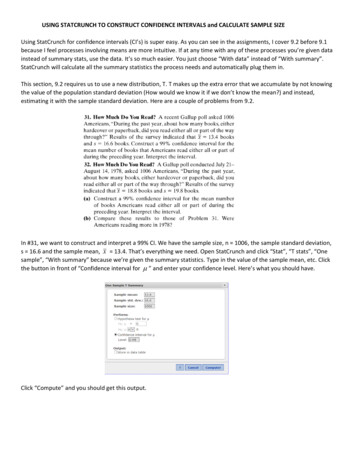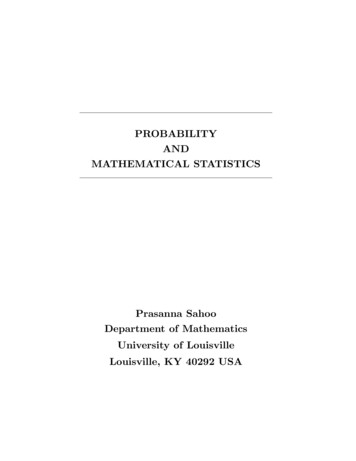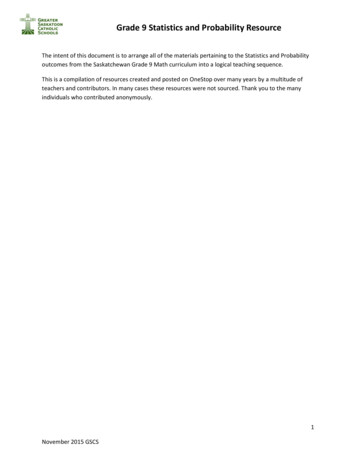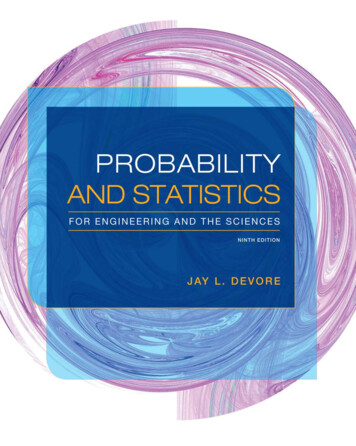
Transcription
5 REASONSto buy your textbooksand course materials at1SAVINGS:2CHOICE:345Prices up to 75% off, daily coupons, and free shipping on orders over 25Multiple format options including textbook, eBook and eChapter rentalsCONVENIENCE:Anytime, anywhere access of eBooks or eChapters via mobile devicesSERVICE:Free eBook access while your text ships, and instant access to online homework productsSTUDY TOOLS:Study tools* for your text, plus writing, research, career and job search resources*availability variesFind your course materials and start saving at:www.cengagebrain.comSource Code: 14M-AA0107Engaged with you.www.cengage.comCopyright 2016 Cengage Learning. All Rights Reserved. May not be copied, scanned, or duplicated, in whole or in part. Due to electronic rights, some third party content may be suppressed from the eBook and/or eChapter(s).Editorial review has deemed that any suppressed content does not materially affect the overall learning experience. Cengage Learning reserves the right to remove additional content at any time if subsequent rights restrictions require it.
Copyright 2016 Cengage Learning. All Rights Reserved. May not be copied, scanned, or duplicated, in whole or in part. Due to electronic rights, some third party content may be suppressed from the eBook and/or eChapter(s).Editorial review has deemed that any suppressed content does not materially affect the overall learning experience. Cengage Learning reserves the right to remove additional content at any time if subsequent rights restrictions require it.
NI NTH E dIT Io NProbability and Statisticsfor Engineeringand the SciencesJay DevoreCalifornia Polytechnic State University, San Luis ObispoAustralia Brazil Mexico SingaporeUnited Kingdom United StatesCopyright 2016 Cengage Learning. All Rights Reserved. May not be copied, scanned, or duplicated, in whole or in part. Due to electronic rights, some third party content may be suppressed from the eBook and/or eChapter(s).Editorial review has deemed that any suppressed content does not materially affect the overall learning experience. Cengage Learning reserves the right to remove additional content at any time if subsequent rights restrictions require it.
This is an electronic version of the print textbook. Due to electronic rights restrictions,some third party content may be suppressed. Editorial review has deemed that any suppressedcontent does not materially affect the overall learning experience. The publisher reserves the rightto remove content from this title at any time if subsequent rights restrictions require it. Forvaluable information on pricing, previous editions, changes to current editions, and alternateformats, please visit www.cengage.com/highered to search by ISBN#, author, title, or keyword formaterials in your areas of interest.Copyright 2016 Cengage Learning. All Rights Reserved. May not be copied, scanned, or duplicated, in whole or in part. Due to electronic rights, some third party content may be suppressed from the eBook and/or eChapter(s).Editorial review has deemed that any suppressed content does not materially affect the overall learning experience. Cengage Learning reserves the right to remove additional content at any time if subsequent rights restrictions require it.
Probability and Statistics for Engineeringand the Sciences, Ninth EditionJay L. DevoreSenior Product Team Manager: RichardStrattonSenior Product Manager: Molly TaylorSenior Content Developer: Jay CampbellProduct Assistant: Spencer ArrittMedia Developer: Andrew CoppolaMarketing Manager: Julie SchusterContent Project Manager: Cathy BrooksArt Director: Linda MayManufacturing Planner: Sandee MilewskiIP Analyst: Christina CiaramellaIP Project Manager: Farah Fard 2016, 2012, 2009, Cengage LearningWCN: 02-200-203ALL RIGHTS RESERVED. No part of this work covered by the copyrightherein may be reproduced, transmitted, stored, or used in any formor by any means graphic, electronic, or mechanical, including but notlimited to photocopying, recording, scanning, digitizing, taping, webdistribution, information networks, or information storage and retrievalsystems, except as permitted under Section 107 or 108 of the 1976United States Copyright Act, without the prior written permission ofthe publisher.For product information and technology assistance, contact us atCengage Learning Customer & Sales Support, 1-800-354-9706For permission to use material from this text or product,submit all requests online at www.cengage.com/permissionsFurther permissions questions can be emailed topermissionrequest@cengage.comProduction Service and Compositor:MPS LimitedUnless otherwise noted, all items Cengage LearningText and Cover Designer: C Miller DesignLibrary of Congress Control Number: 2014946237ISBN: 978-1-305-25180-9Cengage Learning20 Channel Center StreetBoston, MA 02210USACengage Learning is a leading provider of customized learning solutionswith office locations around the globe, including Singapore, the UnitedKingdom, Australia, Mexico, Brazil, and Japan. Locate your local office atwww.cengage.com/global.Cengage Learning products are represented in Canada by NelsonEducation, Ltd.To learn more about Cengage Learning Solutions, visit www.cengage.com.Purchase any of our products at your local college store or at ourpreferred online store www.cengagebrain.com.Printed in the United States of AmericaPrint Number: 01 Print Year: 2014Copyright 2016 Cengage Learning. All Rights Reserved. May not be copied, scanned, or duplicated, in whole or in part. Due to electronic rights, some third party content may be suppressed from the eBook and/or eChapter(s).Editorial review has deemed that any suppressed content does not materially affect the overall learning experience. Cengage Learning reserves the right to remove additional content at any time if subsequent rights restrictions require it.
To my beloved grandsonsPhilip and Elliot, who arehighly statistically significant.Copyright 2016 Cengage Learning. All Rights Reserved. May not be copied, scanned, or duplicated, in whole or in part. Due to electronic rights, some third party content may be suppressed from the eBook and/or eChapter(s).Editorial review has deemed that any suppressed content does not materially affect the overall learning experience. Cengage Learning reserves the right to remove additional content at any time if subsequent rights restrictions require it.
Copyright 2016 Cengage Learning. All Rights Reserved. May not be copied, scanned, or duplicated, in whole or in part. Due to electronic rights, some third party content may be suppressed from the eBook and/or eChapter(s).Editorial review has deemed that any suppressed content does not materially affect the overall learning experience. Cengage Learning reserves the right to remove additional content at any time if subsequent rights restrictions require it.
Contents1Overview and Descriptive Introduction 1Populations, Samples, and Processes 3Pictorial and Tabular Methods in Descriptive Statistics 13Measures of Location 29Measures of Variability 36Supplementary Exercises 47Bibliography 51Introduction 52Sample Spaces and Events 53Axioms, Interpretations,and Properties of Probability 58Counting Techniques 66Conditional Probability 75Independence 85Supplementary Exercises 91Bibliography 94Discrete Random Variables and tion 95Random Variables 96Probability Distributions for Discrete Random Variables 99Expected Values 109The Binomial Probability Distribution 117Hypergeometric and Negative Binomial Distributions 126The Poisson Probability Distribution 131Supplementary Exercises 137Bibliography 140viiCopyright 2016 Cengage Learning. All Rights Reserved. May not be copied, scanned, or duplicated, in whole or in part. Due to electronic rights, some third party content may be suppressed from the eBook and/or eChapter(s).Editorial review has deemed that any suppressed content does not materially affect the overall learning experience. Cengage Learning reserves the right to remove additional content at any time if subsequent rights restrictions require it.
viiiContents4Continuous Random Variables and n 141Probability Density Functions 142Cumulative Distribution Functionsand Expected Values 147The Normal Distribution 156The Exponential and Gamma Distributions 170Other Continuous Distributions 1774.6 Probability Plots 184Supplementary Exercises 193Bibliography 1975Joint Probability Distributionsand Random Samples5.15.25.35.45.56Introduction 198Jointly Distributed Random Variables 199Expected Values, Covariance, and Correlation 213Statistics and Their Distributions 220The Distribution of the Sample Mean 230The Distribution of a Linear Combination 238Supplementary Exercises 243Bibliography 246Point EstimationIntroduction 2476.1 Some General Concepts of Point Estimation 2486.2 Methods of Point Estimation 264Supplementary Exercises 274Bibliography 2757Statistical Intervals Based on a Single SampleIntroduction 2767.1 Basic Properties of Confidence Intervals 2777.2 Large-Sample Confidence Intervalsfor a Population Mean and Proportion 285Copyright 2016 Cengage Learning. All Rights Reserved. May not be copied, scanned, or duplicated, in whole or in part. Due to electronic rights, some third party content may be suppressed from the eBook and/or eChapter(s).Editorial review has deemed that any suppressed content does not materially affect the overall learning experience. Cengage Learning reserves the right to remove additional content at any time if subsequent rights restrictions require it.
Contents7.3 Intervals Based on a Normal Population Distribution 2957.4 Confidence Intervals for the Varianceand Standard Deviation of a Normal Population 304Supplementary Exercises 307Bibliography 3098Tests of Hypotheses Based ona Single SampleIntroduction 3108.18.28.38.48.59Hypotheses and Test Procedures 311z Tests for Hypotheses about a Population Mean 326The One-Sample t Test 335Tests Concerning a Population Proportion 346Further Aspects of Hypothesis Testing 352Supplementary Exercises 357Bibliography 360Inferences Based on Two Samples9.19.29.39.4Introduction 361z Tests and Confidence Intervals for a DifferenceBetween Two Population Means 362The Two-Sample t Test and Confidence Interval 374Analysis of Paired Data 382Inferences Concerning a Difference BetweenPopulation Proportions 3919.5 Inferences Concerning Two Population Variances 399Supplementary Exercises 403Bibliography 40810The Analysis of VarianceIntroduction 40910.1 Single-Factor ANOVA 41010.2 Multiple Comparisons in ANOVA 42010.3 More on Single-Factor ANOVA 426Supplementary Exercises 435Bibliography 436Copyright 2016 Cengage Learning. All Rights Reserved. May not be copied, scanned, or duplicated, in whole or in part. Due to electronic rights, some third party content may be suppressed from the eBook and/or eChapter(s).Editorial review has deemed that any suppressed content does not materially affect the overall learning experience. Cengage Learning reserves the right to remove additional content at any time if subsequent rights restrictions require it.ix
xContents11Multifactor Analysis of Variance11.111.211.311.412Simple Linear Regression and Correlation12.112.212.312.412.513Introduction 437Two-Factor ANOVA with Kij 5 1 438Two-Factor ANOVA with Kij . 1 451Three-Factor ANOVA 4602p Factorial Experiments 469Supplementary Exercises 483Bibliography 486Introduction 487The Simple Linear Regression Model 488Estimating Model Parameters 496Inferences About the Slope Parameter b1 510Inferences Concerning mY ? x* andthe Prediction of Future Y Values 519Correlation 527Supplementary Exercises 437Bibliography 541Nonlinear and Multiple RegressionIntroduction 54213.1 Assessing Model Adequacy 54313.2 Regression with Transformed Variables 55013.3 Polynomial Regression 56213.4 Multiple Regression Analysis 57213.5 Other Issues in Multiple Regression 595Supplementary Exercises 610Bibliography 61814Goodness-of-Fit Tests and CategoricalData AnalysisIntroduction 61914.1 Goodness-of-Fit Tests When CategoryProbabilities Are Completely Specified 62014.2 Goodness-of-Fit Tests for Composite Hypotheses 62714.3 Two-Way Contingency Tables 639Copyright 2016 Cengage Learning. All Rights Reserved. May not be copied, scanned, or duplicated, in whole or in part. Due to electronic rights, some third party content may be suppressed from the eBook and/or eChapter(s).Editorial review has deemed that any suppressed content does not materially affect the overall learning experience. Cengage Learning reserves the right to remove additional content at any time if subsequent rights restrictions require it.
ContentsSupplementary Exercises 648Bibliography 65115Distribution-Free Procedures15.115.215.315.416Introduction 652The Wilcoxon Signed-Rank Test 653The Wilcoxon Rank-Sum Test 661Distribution-Free Confidence Intervals 667Distribution-Free ANOVA 671Supplementary Exercises 675Bibliography 677Quality Control Methods16.116.216.316.416.516.6Introduction 678General Comments on Control Charts 679Control Charts for Process Location 681Control Charts for Process Variation 690Control Charts for Attributes 695CUSUM Procedures 700Acceptance Sampling 708Supplementary Exercises 714Bibliography 715Appendix ative Binomial Probabilities A-2Cumulative Poisson Probabilities A-4Standard Normal Curve Areas A-6The Incomplete Gamma Function A-8Critical Values for t Distributions A-9Tolerance Critical Values for Normal Population Distributions A-10Critical Values for Chi-Squared Distributions A-11t Curve Tail Areas A-12Critical Values for F Distributions A-14Critical Values for Studentized Range Distributions A-20Chi-Squared Curve Tail Areas A-21Approximate Critical Values for the Ryan-Joiner Test ofNormality A-23A.13 Critical Values for the Wilcoxon Signed-Rank Test A-24Copyright 2016 Cengage Learning. All Rights Reserved. May not be copied, scanned, or duplicated, in whole or in part. Due to electronic rights, some third party content may be suppressed from the eBook and/or eChapter(s).Editorial review has deemed that any suppressed content does not materially affect the overall learning experience. Cengage Learning reserves the right to remove additional content at any time if subsequent rights restrictions require it.xi
xiiContentsA.14A.15A.16A.17Critical ValuesCritical ValuesCritical Valuesb Curves for tfor the Wilcoxon Rank-Sum Test A-25for the Wilcoxon Signed-Rank Interval A-26for the Wilcoxon Rank-Sum Interval A-27Tests A-28Answers to Selected Odd-Numbered Exercises A-29Glossary of Symbols/Abbreviations G-1Index I-1Copyright 2016 Cengage Learning. All Rights Reserved. May not be copied, scanned, or duplicated, in whole or in part. Due to electronic rights, some third party content may be suppressed from the eBook and/or eChapter(s).Editorial review has deemed that any suppressed content does not materially affect the overall learning experience. Cengage Learning reserves the right to remove additional content at any time if subsequent rights restrictions require it.
PrefacePurposeThe use of probability models and statistical methods for analyzing data has becomecommon practice in virtually all scientific disciplines. This book attempts to providea comprehensive introduction to those models and methods most likely to be encoun tered and used by students in their careers in engineering and the natural sciences.Although the examples and exercises have been designed with scientists and engi neers in mind, most of the methods covered are basic to statistical analyses in manyother disciplines, so that students of business and the social sciences will also profitfrom reading the book.ApproachStudents in a statistics course designed to serve other majors may be initially skepticalof the value and relevance of the subject matter, but my experience is that students canbe turned on to statistics by the use of good examples and exercises that blend theireveryday experiences with their scientific interests. Consequently, I have worked hardto find examples of real, rather than artificial, data—data that someone thought wasworth collecting and analyzing. Many of the methods presented, especially in the laterchapters on statistical inference, are illustrated by analyzing data taken from publishedsources, and many of the exercises also involve working with such data. Sometimesthe reader may be unfamiliar with the context of a particular problem (as indeed Ioften was), but I have found that students are more attracted by real problems witha somewhat strange context than by patently artificial problems in a familiar setting.Mathematical LevelThe exposition is relatively modest in terms of mathematical development. Substantialuse of the calculus is made only in Chapter 4 and parts of Chapters 5 and 6. In par ticular, with the exception of an occasional remark or aside, calculus appears in theinference part of the book only—in the second section of Chapter 6. Matrix algebrais not used at all. Thus almost all the exposition should be accessible to those whosemathematical background includes one semester or two quarters of differential andintegral calculus.ContentChapter 1 begins with some basic concepts and terminology—population, sample,descriptive and inferential statistics, enumerative versus analytic studies, and so on—and continues with a survey of important graphical and numerical descriptive methods.A rather traditional development of probability is given in Chapter 2, followed by prob ability distributions of discrete and continuous random variables in Chapters 3 and 4,respectively. Joint distributions and their properties are discussed in the first part ofChapter 5. The latter part of this chapter introduces statistics and their sampling distri butions, which form the bridge between probability and inference. The next threexiiiCopyright 2016 Cengage Learning. All Rights Reserved. May not be copied, scanned, or duplicated, in whole or in part. Due to electronic rights, some third party content may be suppressed from the eBook and/or eChapter(s).Editorial review has deemed that any suppressed content does not materially affect the overall learning experience. Cengage Learning reserves the right to remove additional content at any time if subsequent rights restrictions require it.
xivPrefacechapters cover point estimation, statistical intervals, and hypothesis testing based on asingle sample. Methods of inference involving two independent samples and paireddata are presented in Chapter 9. The analysis of variance is the subject of Chapters 10and 11 (single factor and multifactor, respectively). Regression makes its initialappearance in Chapter 12 (the simple linear regression model and correlation)and returns for an extensive encore in Chapter 13. The last three chapters developchi squared methods, distribution free (nonparametric) procedures, and techniquesfrom statistical quality control.Helping Students LearnAlthough the book’s mathematical level should give most science and engineeringstudents little difficulty, working toward an understanding of the concepts and gainingan appreciation for the logical development of the methodology may sometimesrequire substantial effort. To help students gain such an understanding and appreci ation, I have provided numerous exercises ranging in difficulty from many thatinvolve routine application of text material to some that ask the reader to extendconcepts discussed in the text to somewhat new situations. There are many moreexercises than most instructors would want to assign during any particular course,but I recommend that students be required to work a substantial number of them. Ina problem solving discipline, active involvement of this sort is the surest way toidentify and close the gaps in understanding that inevitably arise. Answers to mostodd numbered exercises appear in the answer section at the back of the text. Inaddition, a Student Solutions Manual, consisting of worked out solutions to virtu ally all the odd numbered exercises, is available.To access additional course materials and companion resources, please visitwww.cengagebrain.com. At the CengageBrain.com home page, search for the ISBNof your title (from the back cover of your book) using the search box at the top ofthe page. This will take you to the product page where free companion resources canbe found.New for This EditionThe major change for this edition is the elimination of the rejection regionapproach to hypothesis testing. Conclusions from a hypothesis testing analysisare now based entirely on P values. This has necessitated completely rewritingSection 8.1, which now introduces hypotheses and then test procedures based onP values. Substantial revision of the remaining sections of Chapter 8 was thenrequired, and this in turn has been propagated through the hypothesis testingsections and subsections of Chapters 9–15.Many new examples and exercises, almost all based on real data or actualproblems. Some of these scenarios are less technical or broader in scope thanwhat has been included in previous editions—for example, investigating thenocebo effect (the inclination of those told about a drug’s side effects to experi ence them), comparing sodium contents of cereals produced by three differentmanufacturers, predicting patient height from an easy to measure anatomicalcharacteristic, modeling the relationship between an adolescent mother’s ageand the birth weight of her baby, assessing the effect of smokers’ short termabstinence on the accurate perception of elapsed time, and exploring the impactof phrasing in a quantitative literacy test.More examples and exercises in the probability material (Chapters 2–5) are basedon information from published sources.Copyright 2016 Cengage Learning. All Rights Reserved. May not be copied, scanned, or duplicated, in whole or in part. Due to electronic rights, some third party content may be suppressed from the eBook and/or eChapter(s).Editorial review has deemed that any suppressed content does not materially affect the overall learning experience. Cengage Learning reserves the right to remove additional content at any time if subsequent rights restrictions require it.
PrefacexvThe exposition has been polished whenever possible to help students gain a betterintuitive understanding of various concepts.AcknowledgmentsMy colleagues at Cal Poly have provided me with invaluable support and feedbackover the years. I am also grateful to the many users of previous editions who havemade suggestions for improvement (and on occasion identified errors). A specialnote of thanks goes to Jimmy Doi for his accuracy checking and to Matt Carlton forhis work on the two solutions manuals, one for instructors and the other for students.The generous feedback provided by the following reviewers of this and pre vious editions has been of great benefit in improving the book: Robert L. Armacost,University of Central Florida; Bill Bade, Lincoln Land Community College;Douglas M. Bates, University of Wisconsin–Madison; Michael Berry, West VirginiaWesleyan College; Brian Bowman, Auburn University; Linda Boyle, University ofIowa; Ralph Bravaco, Stonehill College; Linfield C. Brown, Tufts University;Karen M. Bursic, University of Pittsburgh; Lynne Butler, Haverford College;Troy Butler, Colorado State University; Barrett Caldwell, Purdue University; KyleCaudle, South Dakota School of Mines & Technology; Raj S. Chhikara, Universityof Houston–Clear Lake; Edwin Chong, Colorado State University; David Clark,California State Polytechnic University at Pomona; Ken Constantine, TaylorUniversity; Bradford Crain, Portland State University; David M. Cresap, Universityof Portland; Savas Dayanik, Princeton University; Don E. Deal, University ofHouston; Annjanette M. Dodd, Humboldt State University; Jimmy Doi, CaliforniaPolytechnic State University–San Luis Obispo; Charles E. Donaghey, Universityof Houston; Patrick J. Driscoll, U.S. Military Academy; Mark Duva, Universityof Virginia; Nassir Eltinay, Lincoln Land Community College; Thomas English,College of the Mainland; Nasser S. Fard, Northeastern University; Ronald Fricker,Naval Postgraduate School; Steven T. Garren, James Madison University; MarkGebert, University of Kentucky; Harland Glaz, University of Maryland; Ken Grace,Anoka Ramsey Community College; Celso Grebogi, University of Maryland;Veronica Webster Griffis, Michigan Technological University; Jose Guardiola,Texas A&M University–Corpus Christi; K. L. D. Gunawardena, University ofWisconsin–Oshkosh; James J. Halavin, Rochester Institute of Technology; JamesHartman, Marymount University; Tyler Haynes, Saginaw Valley State University;Jennifer Hoeting, Colorado State University; Wei Min Huang, Lehigh University;Aridaman Jain, New Jersey Institute of Technology; Roger W. Johnson, SouthDakota School of Mines & Technology; Chihwa Kao, Syracuse University;Saleem A. Kassam, University of Pennsylvania; Mohammad T. Khasawneh, StateUniversity of NewYork–Binghamton; Kyungduk Ko, Boise State University;Stephen Kokoska, Colgate University; Hillel J. Kumin, University of Oklahoma;Sarah Lam, Binghamton University; M. Louise Lawson, Kennesaw StateUniversity; Jialiang Li, University of Wisconsin–Madison; Wooi K. Lim, WilliamPaterson University; Aquila Lipscomb, The Citadel; Manuel Lladser, University ofColorado at Boulder; Graham Lord, University of California–Los Angeles; JosephL. Macaluso, DeSales University; Ranjan Maitra, Iowa State University; DavidMathiason, Rochester Institute of Technology; Arnold R. Miller, University ofDenver; John J. Millson, University of Maryland; Pamela Kay Miltenberger, WestVirginia Wesleyan College; Monica Molsee, Portland State University; ThomasMoore, Naval Postgraduate School; Robert M. Norton, College of Charleston;Steven Pilnick, Naval Postgraduate School; Robi Polikar, Rowan University; JustinPost, North Carolina State University; Ernest Pyle, Houston Baptist University;Copyright 2016 Cengage Learning. All Rights Reserved. May not be copied, scanned, or duplicated, in whole or in part. Due to electronic rights, some third party content may be suppressed from the eBook and/or eChapter(s).Editorial review has deemed that any suppressed content does not materially affect the overall learning experience. Cengage Learning reserves the right to remove additional content at any time if subsequent rights restrictions require it.
xviPrefaceXianggui Qu, Oakland University; Kingsley Reeves, University of South Florida;Steve Rein, California Polytechnic State University–San Luis Obispo; TonyRichardson, University of Evansville; Don Ridgeway, North Carolina StateUniversity; Larry J. Ringer, Texas A&M University; Nabin Sapkota, Universityof Central Florida; Robert M. Schumacher, Cedarville University; Ron Schwartz,Florida Atlantic University; Kevan Shafizadeh, California State University–Sacramento; Mohammed Shayib, Prairie View A&M; Alice E. Smith, AuburnUniversity; James MacGregor Smith, University of Massachusetts; Paul J. Smith,University of Maryland; Richard M. Soland, The George Washington University;Clifford Spiegelman, Texas A&M University; Jery Stedinger, Cornell University;David Steinberg, Tel Aviv University; William Thistleton, State University ofNew York Institute of Technology; J A Stephen Viggiano, Rochester Instituteof Technology; G. Geoffrey Vining, University of Florida; Bhutan Wadhwa,Cleveland State University; Gary Wasserman, Wayne State University; ElaineWenderholm, State University of New York–Oswego; Samuel P. Wilcock, MessiahCollege; Michael G. Zabetakis, University of Pittsburgh; and Maria Zack, PointLoma Nazarene University.Preeti Longia Sinha of MPS Limited has done a terrific job of supervis ing the book’s production. Once again I am compelled to express my gratitudeto all those people at Cengage who have made important contributions overthe course of my textbook writing career. For this most recent edition, specialthanks go to Jay Campbell (for his timely and informed feedback throughout theproject), Molly Taylor, Ryan Ahern, Spencer Arritt, Cathy Brooks, and AndrewCoppola. I also greatly appreciate the stellar work of all those Cengage Learningsales representatives who have labored to make my books more visible to thestatistical community. Last but by no means least, a heartfelt thanks to my wifeCarol for her decades of support, and to my daughters for providing inspirationthrough their own achievements.Jay DevoreCopyright 2016 Cengage Learning. All Rights Reserved. May not be copied, scanned, or duplicated, in whole or in part. Due to electronic rights, some third party content may be suppressed from the eBook and/or eChapter(s).Editorial review has deemed that any suppressed content does not materially affect the overall learning experience. Cengage Learning reserves the right to remove additional content at any time if subsequent rights restrictions require it.
Overview andDescriptive Statistics1“I took statistics at business school, and it was a transformativeexperience. Analytical training gives you a skill set that differen tiates you from most people in the labor market.”—LaszLo Bock, senior Vice President of PeoPLe oPerations (in charge of aLL hiring) atgoogLeApril 20, 2014, The New York Times, interview with columnist Thomas Friedman“I am not much given to regret, so I puzzled over this one a while.Should have taken much more statistics in college, I think.”—Max LeVchin, PayPaL co-founder, sLide founderQuote of the week from the Web site of the American Statistical Association onNovember 23, 2010“I keep saying that the sexy job in the next 10 years will be statisti cians, and I’m not kidding.”—Hal Varian, CHief eConomist at GooGleAugust 6,
Probability and Statistics for Engineering and the Sciences, Ninth Edition Jay L. Devore Senior Product Team Manager: Richard . 4 Continuous Random Variables and Probability Distributions Introduction 141 4.1 Probability Density Functions 142 4.2 Cumulative Distribution Functions and Expected Values 147
